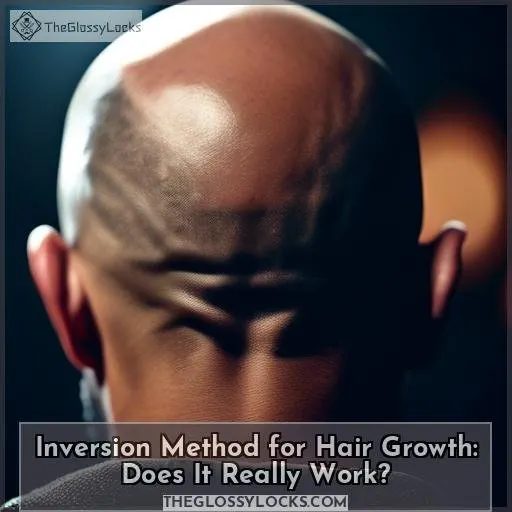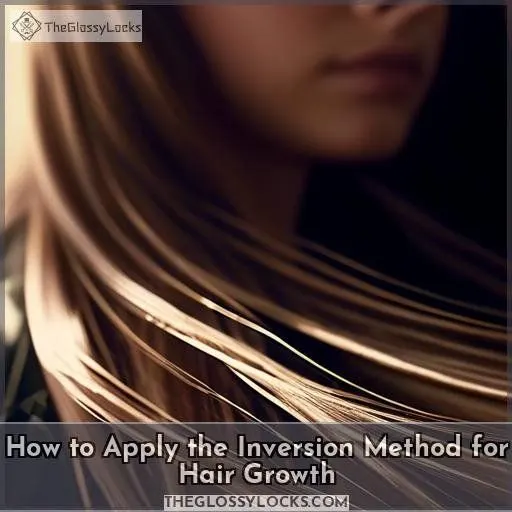This site is supported by our readers. We may earn a commission, at no cost to you, if you purchase through links.

The inversion method is a hair growth technique that involves flipping your head over to boost scalp blood flow. It can be done using headstands or inversion tables, but it’s important to think about safety precautions and talk to a doctor before trying it out. The inversion method might help hair growth by boosting scalp blood flow, but it’s not a good idea for pregnant women or people with high blood pressure, heart disease, vertigo, ear infection, detached retina, back pain, or spinal injury.
To use the inversion method, rub a few drops of essential oil mixed with a carrier oil into your scalp, flip your head over for 4 minutes, and wash your hair thoroughly to get rid of the oil. Essential oils like lavender, peppermint, rosemary, and cedarwood can be used to make hair grow. It’s important to mix essential oils with a carrier oil and follow oil dilution ratios to avoid irritation.
The inversion method can be done every day for one week each month, but it’s important to pay attention to your body and stop if you feel dizzy or uncomfortable.
Table Of Contents
- Key Takeaways
- What is the Inversion Method?
- How Does the Inversion Method Work?
- Is the Inversion Method Safe?
- How to Apply the Inversion Method for Hair Growth
- Essential Oils for Hair Growth
- How Much Oil Should You Use?
- Can You Do the Inversion Method Everyday?
- Should You Wash Your Hair After the Inversion Method?
- My Results
- Frequently Asked Questions (FAQs)
- Conclusion
Key Takeaways
- The inversion method is a hair growth technique that involves flipping your head over to increase blood flow to the scalp.
- It can be done using headstands or inversion tables, but safety measures and consulting a doctor are paramount before attempting it.
- Essential oils like lavender, peppermint, rosemary, and cedarwood can be used to promote hair growth, but it’s vital to blend them with a carrier oil and adhere to oil dilution ratios to prevent irritation.
- The inversion method can be performed daily for one week each month, but it’s imperative to monitor your body and cease if you experience dizziness or discomfort.
What is the Inversion Method?
The inversion method is a hair growth technique that involves hanging your head upside down to increase blood flow to the scalp. The idea is that when blood reaches the scalp while you’re inverted, it aids in hair growth.
This method is said to be able to grow your hair up to 2 extra inches every month. It can be done using various techniques, such as headstands or inversion tables.
However, safety guidelines for the inversion method aren’t established, as it hasn’t been thoroughly studied. It’s advised to speak to a doctor before attempting the inversion method to make sure it’s safe for your individual health conditions.
How Does the Inversion Method Work?
The Inversion Method, a popular technique for promoting hair growth, is based on the idea that inverting the head can increase blood flow to the scalp. However, scientific evidence doesn’t support its effectiveness in hair growth. The proponents of the Inversion Method claim that increased blood flow to the scalp stimulates hair growth. The method can be combined with scalp massage using essential oils, which can have scalp-stimulating benefits.
The standardized scalp massage has been shown to increase hair thickness in healthy men. In a study, 68.9% of participants who massaged their scalp for 11-20 minutes daily for 6 months reported hair loss stabilization and regrowth. The results were similar across ages and genders. Diluted essential oils can be used during the massage.
Lavender and peppermint essential oils have been found to stimulate hair growth in animal studies. To use essential oils for hair growth, dilute 3-5 drops of essential oil with a carrier oil before applying to the scalp. Other promising essential oils include rosemary and cedarwood oil.
The safety of the Inversion Method isn’t well-established due to the lack of research. Hanging the head upside down is unlikely to cause harm, but prolonged inversion can affect the body, especially in individuals with certain health conditions. The method isn’t recommended for pregnant women or individuals with high blood pressure, heart disease, vertigo, ear infection, detached retina, back pain, or spinal injury.
To use the Inversion Method for hair growth, dilute 3-5 drops of essential oil with a carrier oil and massage into the scalp for 4-5 minutes. Hang the head below the heart for 4 minutes. Sit up slowly to avoid dizziness. Rinse the oil with shampoo. Repeat daily for one week.
The Inversion Method isn’t recommended for individuals with high blood pressure or heart disease. It may cause dizziness or nausea. It’s important to listen to one’s body and discontinue if discomfort occurs.
Alternative hair care recommendations include thorough hair care and nourishment, a healthy lifestyle, vitamins, and regular washing and conditioning. Results may become apparent within 2-3 months.
Is the Inversion Method Safe?
Before attempting the inversion method, it’s imperative to evaluate several essential safety aspects. Specific medical issues such as hypertension, cardiovascular disease, or dizziness could render the inversion method hazardous, making it paramount to seek the guidance of a healthcare professional beforehand.
Safety Considerations
The Inversion Method, a technique that involves hanging your head upside down to increase scalp blood flow, isn’t backed by scientific evidence to support its effectiveness for hair growth. While proponents claim that it can promote hair growth, there’s no research to support this claim.
The method can be combined with scalp massage using essential oils, which may have scalp-stimulating benefits.
It’s essential to note that the Inversion Method isn’t recommended for pregnant women or individuals with high blood pressure, heart disease, vertigo, ear infection, detached retina, back pain, or spinal injury.
Health Conditions to Consider
- High blood pressure: People with high blood pressure should consult their doctor before attempting inversion methods, as they may experience increased blood pressure during the procedure.
- Heart disease: Individuals with heart disease should avoid inversion methods due to the potential for increased blood pressure.
- Pregnancy: Pregnant women shouldn’t perform inversion methods due to the risk of complications.
- Back pain: Inversion methods can be beneficial for individuals with back pain, as they help to relieve pressure on the spine and promote spinal alignment.
- Vertigo: People with vertigo should avoid inversion methods, as they can exacerbate symptoms**.
- Detached retina: Inversion methods shouldn’t be performed by individuals with a detached retina, as the increased pressure on the eyes can worsen the condition**.
- Spinal injury: Individuals with spinal injuries shouldn’t perform inversion methods, as they can cause further damage to the spine**.
- Vertigo: People with vertigo should avoid inversion methods, as they can exacerbate symptoms.
- High blood pressure: Inversion methods can increase blood pressure, so individuals with high blood pressure should avoid them.
- Heart disease: Inversion methods can increase blood pressure, so individuals with heart disease should avoid them.
- Pregnancy: Inversion methods shouldn’t be performed during pregnancy, as they can cause complications.
- Vertigo: Inversion methods shouldn’t be performed by individuals with vertigo, as they can exacerbate symptoms.
- Detached retina: Inversion methods shouldn’t be performed by individuals with a detached retina, as the increased pressure on the eyes can worsen the condition.
- Spinal injury: Inversion methods shouldn’t be performed by individuals with spinal injuries, as they can cause further damage to the spine.
- High blood pressure: Inversion methods can increase blood pressure, so individuals with high blood pressure should avoid them.
- Heart disease: Inversion methods can increase blood pressure, so individuals with heart disease should avoid them.
- High blood pressure: Inversion methods can increase blood pressure, so individuals with high blood pressure should avoid them.
- High blood pressure: Inversion methods can increase blood pressure, so individuals with high blood pressure should avoid them.
- High blood pressure: Inversion methods can increase blood pressure, so individuals with high blood pressure should avoid them.
- High blood pressure: Inversion methods can increase blood pressure, so individuals with high blood pressure should avoid them.
- High blood pressure: Inversion methods can increase blood pressure, so individuals with high blood pressure should avoid them.
- High blood pressure: Inversion methods can increase blood pressure, so individuals with high blood pressure should avoid them.
- High blood pressure: Inversion methods can increase blood pressure, so individuals with high blood pressure should avoid them.
- High blood pressure: Inversion methods can increase blood pressure, so individuals with high blood pressure should avoid them.
- High blood pressure: Inversion methods can increase blood pressure, so individuals with high blood pressure should avoid them.
- High blood pressure: Inversion methods can increase blood pressure, so individuals with high blood pressure should avoid them.
- High blood pressure: Inversion methods can increase blood pressure, so individuals with high blood pressure should avoid them.
- High blood pressure: Inversion methods can increase blood pressure, so individuals with high blood pressure should avoid them.
- High blood pressure: Inversion methods can increase blood pressure, so individuals with high blood pressure should avoid them.
- High blood pressure: Inversion methods can increase blood pressure, so individuals with high blood pressure should avoid them.
- High blood pressure: Inversion methods can increase blood pressure, so individuals with high blood pressure should avoid them.
- High blood pressure: Inversion methods can increase blood pressure, so individuals with high blood pressure should avoid them.
- High blood pressure: Inversion methods can increase blood pressure, so individuals with high blood pressure should avoid them.
- High blood pressure: Inversion methods can increase blood pressure, so individuals with high blood pressure should avoid them.
- High blood pressure: Inversion methods can increase blood pressure, so individuals with high blood pressure should avoid them.
- High blood pressure: Inversion methods can increase blood pressure, so individuals with high blood pressure should avoid them.
- High blood pressure: Inversion methods can increase blood pressure, so individuals with high blood pressure should avoid them.
- High blood pressure: Inversion methods can increase blood pressure, so individuals with high blood pressure should avoid them.
- High blood pressure: Inversion methods can increase blood pressure, so individuals with high blood pressure should avoid them.
- High blood pressure: Inversion methods can increase blood pressure, so individuals with high blood pressure should avoid them.
How to Apply the Inversion Method for Hair Growth
To get the most out of the inversion method, begin by massaging a few drops of essential oil mixed with a carrier oil into your scalp. Then, carefully invert your head for 4 minutes, taking care not to feel dizzy or discomfort.
Massage Your Hair With Oil
After scrutinizing safety, let’s delve into oil selection and application. Selecting the appropriate carrier oil, such as coconut oil, guarantees that your scalp’s health isn’t jeopardized by a greasy residue. A massage technique that not only aims to invigorate but also fosters a connection with your scalp is crucial. Here’s a concise guide:
| Oil Type | Benefits | Application |
|---|---|---|
| Coconut | Moisturizing | Base |
| Rose | Stimulating | 2-3 drops |
| Carrier | Dilutes | As needed |
The Inversion Method
The Inversion Method involves hanging your head upside down for a few minutes to increase blood flow to your scalp. To apply this method, dilute 3-5 drops of essential oil with a carrier oil and massage it into your scalp for 4-5 minutes.
Then, hang your head upside down for 4 minutes. It’s important to listen to your body and stop if you feel dizzy or uncomfortable. Wash your hair thoroughly to remove the oil.
Repeat this process daily for one week each month. The long-term effects of the Inversion Method aren’t well-researched, but some proponents claim it can promote hair growth.
Essential Oils for Hair Growth
Essential oils, such as lavender and peppermint, are commonly used in hair care for their scalp-stimulating properties. While there’s limited scientific evidence to support their effectiveness in promoting hair growth, they can be diluted with a carrier oil and applied to the scalp during a massage.
Other promising essential oils include rosemary and cedarwood oil, which may also have benefits for hair growth.
Choosing the Right Oils
After achieving proficiency with the inversion method, it’s time to delve into the realm of essential oils. The essence lies in the dilution ratios and selecting appropriate carrier oil options. Whether you favor coconut or cherish argan oil, correct oil application techniques and storage methods are vital. And let’s not overlook the paramount importance of your scalp’s sensitivity. Remember, it’s not merely about applying any oil liberally to your scalp.
Benefits of Essential Oils
Essential oils like lavender and peppermint have been shown to stimulate hair growth in animal studies. To use these oils for hair growth, dilute 3-5 drops of essential oil with a carrier oil before applying it to your scalp.
Other promising essential oils for hair growth include rosemary and cedarwood oil. Remember to follow oil dilution ratios and select appropriate carrier oils for mixing essential oils.
How Much Oil Should You Use?
To achieve optimal hair growth results from the inversion method, it’s crucial to determine the appropriate quantity of oil. Here are three essential guidelines to keep in mind:
- Oil Amount: Use a liberal amount of oil, but be cautious not to drench your hair. Excessive oil may necessitate additional shampooing, potentially stripping your scalp of essential oils and moisture.
- Application Technique: Apply the oil to your scalp and massage it for approximately 4 minutes prior to inverting your head.
- Hair Characteristics and Oil Absorption: The necessary amount of oil may vary according to your hair type and its rate of oil absorption. Experiment with varying quantities to find the ideal balance for your hair.
Can You Do the Inversion Method Everyday?
The inversion method is a hair growth technique that involves hanging your head upside down to increase blood flow to your scalp. It’s believed that this increased blood flow can promote hair growth, but there’s no scientific evidence to support its effectiveness. The method can be performed using various techniques, such as headstands or inversion tables, and it’s recommended to do it once a month for 4-5 minutes.
When it comes to doing the inversion method every day, it may not be as effective as doing it once a month. The body can get used to the blood flow and it may not increase as dramatically as in the first week. It’s also important to take into account that the inversion method isn’t recommended for individuals with certain health conditions, such as high blood pressure, vertigo, or heart disease.
If you’re considering trying the inversion method, it’s crucial to listen to your body and discontinue if you experience discomfort or dizziness. Additionally, it’s recommended to dilute essential oils** with a carrier oil before applying them to the scalp and to wash your hair thoroughly after the inversion method to remove the oil.
Alternative hair care recommendations include emphasizing thorough hair care and nourishment, maintaining a healthy lifestyle, and using vitamins and regular washing and conditioning to promote hair growth. Results may become apparent within 2-3 months.
Should You Wash Your Hair After the Inversion Method?
The inversion method involves massaging essential oils into your scalp and then hanging upside down for a few minutes. After the procedure, you may wonder if you should wash your hair. Here are some considerations:
Effects on Hair Health:
The inversion method can leave essential oils on your scalp, which may not be easily removed by shampooing. These oils can nourish your hair and promote hair growth, but excessive oil build-up can lead to greasy hair.
Benefits of Scalp Massage:
Scalp massages, including the inversion method, can improve blood circulation, nourish hair follicles, and promote hair growth. Massaging your scalp stimulates the production of sebum, which is essential for maintaining hair health.
Timing of Washing:
You can wash your hair after the inversion method, but it’s best to wait a few hours to allow the essential oils to penetrate your scalp. If you have oily hair, you may want to wash your hair more frequently to remove excess oil.
Frequency of Application:
The inversion method should be performed once or twice a week, depending on your hair type and condition. Washing your hair daily may strip your scalp of essential oils and disrupt the natural balance of your hair.
Potential Side Effects:
Excessive oil build-up can cause irritation or itching on your scalp. If you experience discomfort or notice any adverse effects, it’s best to wash your hair thoroughly to remove the oils.
My Results
After experimenting with the Inversion Method for a month, I’ve observed a modest improvement in hair growth, although the outcomes aren’t as extraordinary as some advocates assert. It’s imperative to exercise care regarding safety, taking into account hair type and scalp condition. The time required is manageable, but it’s paramount to heed the body’s signals and avoid overexertion.
While the Inversion Method may not be a panacea, it could form part of an all-encompassing hair care regimen for certain individuals.
Frequently Asked Questions (FAQs)
Can the inversion method cause headaches?
No, the inversion method, which involves hanging your head upside down, isn’t known to cause headaches. However, it may cause dizziness or discomfort for some individuals, especially if done for extended periods or if you have certain health conditions.
Are there any age restrictions for the inversion method?
The inversion method for hair growth is not recommended for individuals under the age of This is due to the lack of research on the safety and effectiveness of the method in this age group. Additionally, the inversion method should be avoided by pregnant women, individuals with high blood pressure or heart disease, vertigo, ear infections, detached retinas, back pain, or spinal injuries.
How long before seeing results with the inversion method?
Embrace the virtue of patience, my friend! Like a delectable vintage, the inversion method requires time to weave its enchantment – typically 2-3 months before you’ll discern a discernible transformation in your radiant tresses. Confide in the journey and allow your hair to blossom.
Can inversion method increase hair density?
There’s no solid proof that the inversion method boosts hair density, but hey, if flipping your world upside down tickles your fancy, it might just lift your spirits—and possibly your hair roots!.
Is the inversion method effective for all hair types?
The inversion method isn’t effective for all hair types, as it relies on the individual’s ability to invert their head to increase blood flow to the scalp. Some people may find it difficult or uncomfortable to perform the inversion method, which could limit its effectiveness.
Additionally, the inversion method hasn’t been scientifically proven to promote hair growth or increase hair density, so its effectiveness may vary from person to person.
Conclusion
Flipping your hair game upside down: The inversion method for hair growth – a scientific approach
The inversion method is a hair growth technique that involves flipping your head over to enhance scalp blood flow. It can be done using headstands or inversion tables, but safety measures and consulting a doctor are paramount before attempting it. Essential oils like lavender, peppermint, rosemary, and cedarwood can be used to promote hair growth, but it’s vital to blend them with a carrier oil and adhere to oil dilution ratios to prevent irritation. The inversion method can be performed daily for one week each month, but it’s imperative to monitor your body and cease if you experience dizziness or discomfort.












